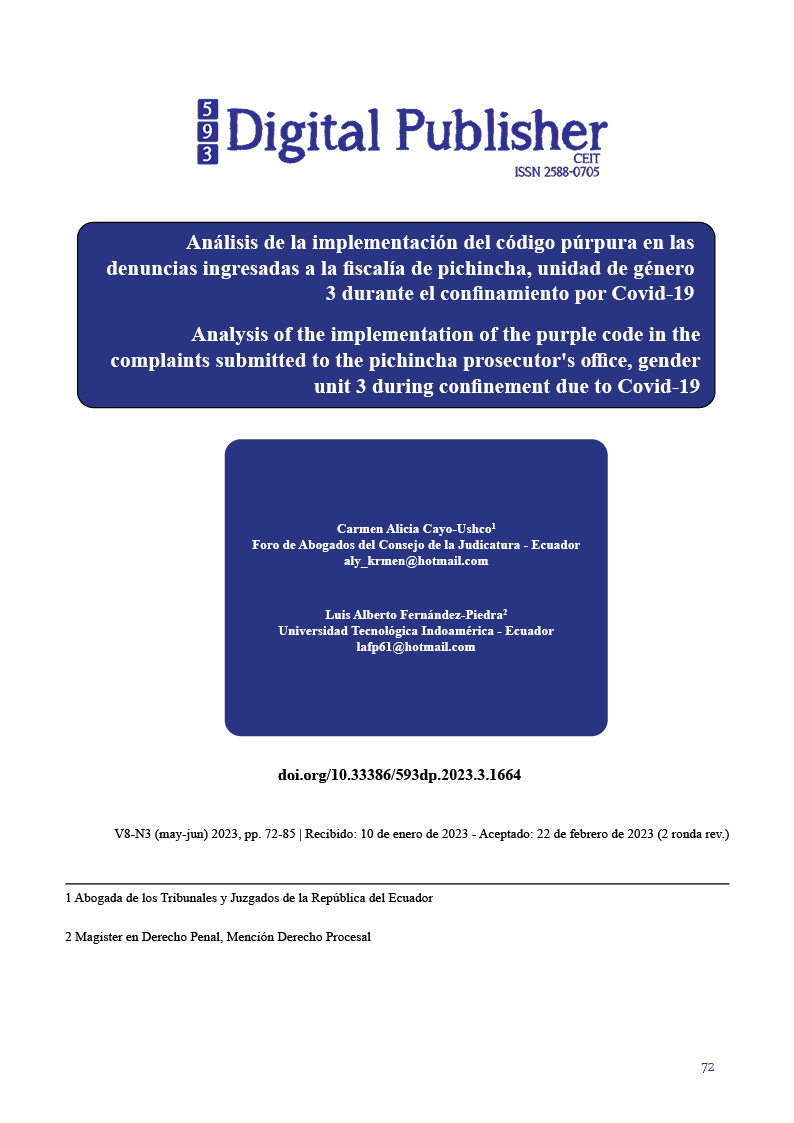Analysis of the implementation of the purple code in the complaints submitted to the pichincha prosecutor's office, gender unit 3 during confinement due to covid-19
Main Article Content
Abstract
This article consists of analyzing the implementation of the "Purple Code" in the complaints submitted to the Pichincha Prosecutor's Office, Gender Unit 3, located at Av. Amazonas and Ramón Roca during the confinement by COVID-19. Being the year 2020 the most hostile scenario of violence against women and members of the family nucleus due to confinement as a result of the pandemic. This protocol is activated in Educational and Health Centers, in order to investigate crimes of psychological, physical and sexual violence. The main objective is to establish whether the implementation of the purple code is sufficient to eradicate violence against women or members of the family nucleus; and identify the main factors for which the complaints do not reach the courts. The methodology used is mixed, considering that it is necessary to investigate quantitative-qualitative data through the complaints filed in gender unit 3, by activating the "Purple Code" protocol and through the survey research technique. practiced, conclusions are reached on the topic addressed.
Downloads
Article Details

This work is licensed under a Creative Commons Attribution-NonCommercial-ShareAlike 4.0 International License.
1. Derechos de autor
Las obras que se publican en 593 Digital Publisher CEIT están sujetas a los siguientes términos:
1.1. 593 Digital Publisher CEIT, conserva los derechos patrimoniales (copyright) de las obras publicadas, favorece y permite la reutilización de las mismas bajo la licencia Licencia Creative Commons 4.0 de Reconocimiento-NoComercial-CompartirIgual 4.0, por lo cual se pueden copiar, usar, difundir, transmitir y exponer públicamente, siempre que:
1.1.a. Se cite la autoría y fuente original de su publicación (revista, editorial, URL).
1.1.b. No se usen para fines comerciales u onerosos.
1.1.c. Se mencione la existencia y especificaciones de esta licencia de uso.
References
Arroyo, L (2006). Victimológica; Una Visión desde el Saber Penal-Criminológico a la afirmación Científica de la Imputación Objetiva. Manta: Arroyo Edición. Quito Ecuador.
Asociación Latinoamericana para el Desarrollo Alternativo “Aldea”. (2021). obtenido de http://www.fundacionaldea.org/noticias-aldea/mapaspichincha.
Benítez, O. S. (2021). La (in) trascendencia constitucional de la perspectiva de género: Reflexiones a partir de las dos decisiones del Comité CEDAW condenatorias de España. Revista de Derecho Político, (111), 77-108.
Bosch-Fiol, E., & Ferrer-Pérez, V. A. (2012). Nuevo mapa de los mitos sobre la violencia de género en el siglo XXI. Psicothema, 24(4), 548-554.
Carrasco, J. (2004) Violencia Física, Psicológica y Sexual en el Ámbito de la Pareja: Papel del Contexto. Clínica y Salud.
Código Orgánico Integral Penal [C.O.I.P] (2014, 10 de febrero). Obtenido de https://tbinternet.ohchr.org/Treaties/CEDAW/Shared%20Documents/ECU/INT_CEDAW_ARL_ECU_18950_S.pdf.
Constitución de la República del Ecuador [Const.] (2018, 20 de octubre). Obtenido de https://www.ambiente.gob.ec/wp-content/uploads/downloads/2018/09/Constitucion-de-la-Republica-del-Ecuador.pdf Fuentes. (2008).
Declaración sobre la eliminación de la violencia contra la mujer [DEVCM.] (1993, 20 de diciembre). Obtenido de: https://www.ohchr.org/es/instruments-mechanisms/instruments/declaration-elimination-violence-against-women
Díaz, A. (2009). La efectividad de las medidas de protección frente a la violencia familiar. Revista Electrónica del Trabajador Judicial.
Diez Ripollés (1989), título VIII del libro II, Delitos contra la Libertad Sexual.
El Español: El origen del 8-M morado: así fue el incendio de la fábrica de camisas donde murieron 140 mujeres; 2022. Obtenido de: https://www.elespanol.com/mujer/actualidad/20200307/origen-8m-morado-incendio-fabrica-camisas-murieron-mujeres-feministas-mujer-seo/472703325_0.html
Esplugues, J. (2012). Claves para entender la Violencia en el Siglo XII. Vol. XX. Madrid: Barcelona España. Pág. 147.
Facio, A. (1998). La Carta Magna de todas las mujeres. Módulo de la CEDAW, 12.
Ferrer Pérez, V. A., y Bosch-Fiol, E. (2019). El género en el análisis de la violencia contra las mujeres en la pareja: de la “ceguera” de género a la investigación específica del mismo. Anuario de Psicología Jurídica, pág. 29, 69-76.
Gómez, L., & Moyna (como lo cita Luzón, 2015). Compendio de Derecho Penal, Parte Especial. (pág. 103).
Gorjón, M. (2020). El Delito de Violencia Habitual. Editorial Bosch. Madrid España.
Guerrero, M. F. R. (2017). Violencia física contra la mujer: una propuesta de abordaje desde un servicio de salud. Revista Cuidarte, 8(2), 1656-1667.
Larrosa, M. P. (2010). Violencia de género: violencia psicológica. FORO. Revista de Ciencias Jurídicas y Sociales, Nueva Época, (11-12), 353-376.
Ministerio de Salud Pública: Atención integral a víctimas de violencia basada en género y graves violaciones a los derechos humanos. Norma técnica. Quito: Dirección Nacional de Derechos Humanos, Género e Inclusión; 2019. Obtenido de https://www.salud.gob.ec/wp-content/uploads/2021/03/Norma-tecnica-de-VBG-y-GVDH-.pdf
Pinto, T. (2007). Derecho Penal Especial. Editorial Líber. Caracas Venezuela.
Piva, L. (2021). Violencia Intrafamiliar, Femicidio, Abortó acorde al COIP. Tratados y Convenioz Internacionales sobre Violencia contra la Mujer y la Familia: Quito:Comité Editorial. QuitoEcuador.
Ramos-Lira, L., Saltijeral-Méndez, M. T., Romero-Mendoza, M., Caballero-Gutiérrez, M. A., & Martínez-Vélez, N. A. (2001). Violencia sexual y problemas asociados en una muestra de usuarias de un centro de salud. Salud pública de México, 43(3), 182-191.
Sánchez, S (como lo cita Percy, 2012). Derecho Penal, Parte General. (pág. 136)
Segato, R. L. (2016). La Guerra contra las Mujeres. Traficantes de Sueños. Madrid: Traficantes de Sueños Edición.
Segato, R. (2017). La Estructura de Género y el Mandato de Violación. Caballero, Edith; de Santiago, Alejandra y González, Gabriela, Mujeres intelectuales: feminismo y liberación en América Latina y el Caribe, pág. 299-332.
Serrano, M. (2004). Sobre la Concepción Legal del Delito. Introducción a la Criminología. 2°ed. Madrid.
Vaca, R (2015). Derecho Procesal Penal Ecuatoriano. Quito: Ediciones Legales. Quito Ecuador. 2020.



